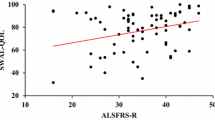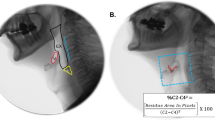Abstract
Dysphagia in Friedreich ataxia (FRDA) and its impact on quality of life is not adequately understood. The objective of this study was to characterise dysphagia in FRDA and to determine the impact of swallowing dysfunction on activities, participation, and sense of well-being. Thirty-six individuals with a confirmed diagnosis of FRDA were assessed via a clinical bedside examination (CBE), the Royal Brisbane Hospital outcome measure for swallowing, an oral-motor examination and the Australian therapy outcome measures for speech and swallowing (AusTOMS). Data on swallowing function, diet modification and swallowing strategies were collated. Thirty-three (91.67 %) participants exhibited clinical signs of dysphagia according to the CBE, and all participants received ratings indicating swallowing difficulties on at least one other measure. Dysphagia in FRDA is characterised by oral and pharyngeal stage impairment relating to incoordination, weakness and spasticity. A significant positive correlation was found between the severity of impairment, activity, participation and distress/well-being on the AusTOMS, suggesting that swallowing function decreases with overall reductions in quality of life. A significant correlation was found between activity on the AusTOMS and disease duration (r = −0.283, p = 0.012). No significant correlations were found between dysphagia severity and GAA repeat length, age of onset or disease severity. Participants employing diet modification and swallowing strategies demonstrated higher dysphagia severity, activity limitations and participation restrictions. These data advocate a holistic approach to dysphagia management in FRDA. Early detection of swallowing impairment and consideration of the potential impact dysphagia has on quality of life should be key aspects in disease management.
Similar content being viewed by others
References
Campuzano V, Montermini L, Moltò MD, Pianese L, Cossée M, Cavalcanti F, Monros E, Rodius F, Duclos F, Monticelli A, Zara F, Cañizares J, Koutnikova H, Bidichandani SI, Gellera C, Brice A, Trouillas P, De Michele G, Filla A, De Frutos R, Palau F, Patel PI, Di Donato S, Mandel J-L, Cocozza S, Koenig M, Pandolfo M (1996) Friedreich’s ataxia: autosomal recessive disease caused by an intronic GAA triplet repeat expansion. Science 271:1423–1427
Vankan P (2013) Prevalence gradients of Friedreich’s ataxia and R1b haplotype in Europe co-localize, suggesting a common Palaeolithic origin in the Franco-Cantabrian ice age refuge. J Neurochem 126:11–20
Delatycki MB, Williamson R, Forrest SM (2000) Friedreich ataxia: an overview. J Med Genet 37:1–8
Schulz JB, Boesch S, Burk K, Durr A, Giunti P, Mariotti C, Pousset F, Schols L, Vankan P, Pandolfo M (2009) Diagnosis and treatment of Friedreich ataxia: a European perspective. Nat Rev Neurol 5:222–234
Koeppen AH (2011) Friedreich’s ataxia: pathology, pathogenesis, and molecular genetics. J Neurol Sci 303:1–12
Weidemann F, Störk S, Liu D, Hu K, Herrmann S, Ertl G, Niemann M (2013) Cardiomyopathy of Friedreich ataxia. J Neurochem 126:88–93
Pandolfo M (2009) Friedreich ataxia: the clinical picture. J Neurol 256:3–8
La Pean A, Jeffries N, Grow C, Ravina B, Di Prospero NA (2008) Predictors of progression in patients with Friedreich ataxia. Mov Disord 23:2026–2032
Harding AE (1981) Friedreich’s ataxia: a clinical and genetic study of 90 families with an analysis of early diagnostic criteria and intrafamilial clustering of clinical features. Brain 104:589–620
Corben LA, Georgiou-Karistianis N, Fahey MC, Storey E, Churchyard A, Horne M, Bradshaw JL, Delatycki MB (2006) Towards an understanding of cognitive function in Friedreich ataxia. Brain Res Bull 70:197
Corben LA, Georgiou-Karistianis N, Bradshaw JL, Hocking DR, Churchyard AJ, Delatycki MB (2011) The Fitts task reveals impairments in planning and online control of movement in Friedreich ataxia: reduced cerebellar-cortico connectivity? Neuroscience 192:382–390
Ekberg O, Hamdy S, Woisard V, Wuttge–Hannig A, Ortega P (2002) Social and psychological burden of dysphagia: its impact on diagnosis and treatment. Dysphagia 17:139–146
Logemann JA (1998) Evaluation and treatment of swallowing disorders. PRO-ED, Austin
Nagaya M, Kachi T, Yamada T, Sumi Y (2004) Videofluorographic observations on swallowing in patients with dysphagia due to neurodegenerative diseases. Nagoya J Med Sci 67:17–23
Nilsson H, Ekberg O, Olsson R, Hindfelt B (1996) Swallowing in hereditary sensory ataxia. Dysphagia 11:140–143
Ramio-Torrentia L, Gomez E, Genis D (2006) Swallowing in degenerative ataxias. J Neurol 253:875–881
Rüb U, Brunt ER, Petrasch-Parwez E, Schöls L, Theegarten D, Auburger G, Seidel K, Schultz C, Gierga K, Paulson H, Van Broeckhoven C, Deller T, De Vos RAI (2006) Degeneration of ingestion-related brainstem nuclei in spinocerebellar ataxia type 2, 3, 6 and 7. Neuropathol Appl Neurobiol 32:635–649
Folker JE, Murdoch BE, Cahill LM, Delatycki MB, Corben LA, Vogel AP (2010) Dysarthria in Friedreich’s ataxia: a perceptual analysis. Folia Phoniatrica et Logopaedia 62:97–103
Folker JE, Murdoch BE, Rosen KM, Cahill LM, Delatycki MB, Corben LA, Vogel AP (2012) Differentiating profiles of speech impairments in Friedreich’s ataxia: a perceptual and instrumental approach. Int J Lang Commun Disord 47:65–76
Rosen KM, Folker JE, Vogel AP, Corben LA, Murdoch BE, Delatycki MB (2012) Longitudinal change in dysarthria associated with Friedreich ataxia: a potential clinical endpoint. J Neurol 259:2471–2477
Brendel B, Ackermann H, Berg D, Lindig T, Schölderle T, Schöls L, Synofzik M, Ziegler W (2013) Friedreich ataxia: dysarthria profile and clinical data. Cerebellum 12:475–484
Eslick GD, Talley NJ (2008) Dysphagia: epidemiology, risk factors and impact on quality of life––a population-based study. Aliment Pharmacol Ther 27:971–979
Farri A, Accornero A, Burdese C (2007) Social importance of dysphagia: its impact on diagnosis and therapy. Acta Otorhinolaryngol Ital 27:83–86
WHO (2001) International classification of functioning, disability and health (ICF). In: International classification of functioning, disability and health (ICF). World Health Organisation, Geneva, Switzerland
Threats TT (2007) Use of the ICF in dysphagia management. Semin Speech Lang 28(323):333
Perry A, Skeat J (2004) AusTOMS for speech pathology. LaTrobe University, Melbourne
Ward EC, Conroy AL (1999) Validity, reliability and responsivity of the Royal Brisbane Hospital outcome measure for swallowing. Asia Pac J Speech Lang Hear 4:109–129
Skeat J, Perry A (2005) Outcome measurement in dysphagia: not so hard to swallow. Dysphagia 20:113–122
Morris M, Perry A, Unsworth C, Skeat J, Taylor N, Dodd K, Duncombe D, Duckett S (2005) Reliability of the Australian therapy outcome measures for quantifying disability and health. Int J Ther Rehabil 12:340–346
Fahey MC, Corben L, Collins V, Churchyard AJ, Delatycki MB (2007) How is disease progress in Friedreich’s ataxia best measured? A study of four rating scales. J Neurol Neurosurg Psychiatry 78:411–413
Subramony SH, May W, Lynch D, Gomez C, Fischbeck K, Hallett M, Taylor P, Wilson R, Ashizawa T (2005) Measuring Friedreich ataxia: interrater reliability of a neurologic rating scale. Neurology 64:1261–1262
Folker JE, Murdoch BE, Cahill LM, Rosen KM, Delatycki MB, Corben LA, Vogel AP (2010) Differentiating impairment levels in temporal versus spatial aspects of linguopalatal contacts in Friedreich’s ataxia. Mot Control 14:490–508
Walshe M, Miller N (2011) Living with acquired dysarthria: the speaker’s perspective. Disabil Rehabil 33:195–203
Acknowledgments
Our gratitude goes to those individuals who participated in the research. We thank the Friedreich Ataxia Research Association (Australasia) and Friedreich Ataxia Research Alliance (USA) for supporting our research. APV and LC are funded by National Health and Medical Research Council of Australia (NHMRC) Early Career Fellowships. MBD is a NHMRC Practitioner Fellow.
Conflicts of interest
None of the authors declare a conflict of interest.
Author information
Authors and Affiliations
Corresponding author
Additional information
A. P. Vogel and S. E. Brown are joint first authors.
Electronic supplementary material
Below is the link to the electronic supplementary material.
Rights and permissions
About this article
Cite this article
Vogel, A.P., Brown, S.E., Folker, J.E. et al. Dysphagia and swallowing-related quality of life in Friedreich ataxia. J Neurol 261, 392–399 (2014). https://doi.org/10.1007/s00415-013-7208-4
Received:
Revised:
Accepted:
Published:
Issue Date:
DOI: https://doi.org/10.1007/s00415-013-7208-4




